简介
队列是是只允许在一端进行插入操作,而在另一端进行删除操作的线性表。
队列是一种先进先出的线性表,简称FIFO允许插入的以端称为队尾,允许删除的一端被称为队头。
入队

出队
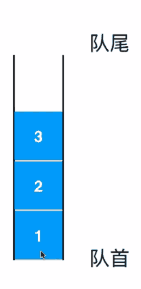
数组实现队列
public class Array<E> {
private E[] data;
private int size;
// 构造函数,传入数组的容量capacity构造Array
public Array(int capacity){
data = (E[])new Object[capacity];
size = 0;
}
// 无参数的构造函数,默认数组的容量capacity=10
public Array(){
this(10);
}
// 获取数组的容量
public int getCapacity(){
return data.length;
}
// 获取数组中的元素个数
public int getSize(){
return size;
}
// 返回数组是否为空
public boolean isEmpty(){
return size == 0;
}
// 在index索引的位置插入一个新元素e
public void add(int index, E e){
if(index < 0 || index > size)
throw new IllegalArgumentException("Add failed. Require index >= 0 and index <= size.");
if(size == data.length)
resize(2 * data.length);
for(int i = size - 1; i >= index ; i --)
data[i + 1] = data[i];
data[index] = e;
size ++;
}
// 向所有元素后添加一个新元素
public void addLast(E e){
add(size, e);
}
// 在所有元素前添加一个新元素
public void addFirst(E e){
add(0, e);
}
// 获取index索引位置的元素
public E get(int index){
if(index < 0 || index >= size)
throw new IllegalArgumentException("Get failed. Index is illegal.");
return data[index];
}
public E getLast(){
return get(size - 1);
}
public E getFirst(){
return get(0);
}
// 修改index索引位置的元素为e
public void set(int index, E e){
if(index < 0 || index >= size)
throw new IllegalArgumentException("Set failed. Index is illegal.");
data[index] = e;
}
// 查找数组中是否有元素e
public boolean contains(E e){
for(int i = 0 ; i < size ; i ++){
if(data[i].equals(e))
return true;
}
return false;
}
// 查找数组中元素e所在的索引,如果不存在元素e,则返回-1
public int find(E e){
for(int i = 0 ; i < size ; i ++){
if(data[i].equals(e))
return i;
}
return -1;
}
// 从数组中删除index位置的元素, 返回删除的元素
public E remove(int index){
if(index < 0 || index >= size)
throw new IllegalArgumentException("Remove failed. Index is illegal.");
E ret = data[index];
for(int i = index + 1 ; i < size ; i ++)
data[i - 1] = data[i];
size --;
data[size] = null; // loitering objects != memory leak
if(size == data.length / 4 && data.length / 2 != 0)
resize(data.length / 2);
return ret;
}
// 从数组中删除第一个元素, 返回删除的元素
public E removeFirst(){
return remove(0);
}
// 从数组中删除最后一个元素, 返回删除的元素
public E removeLast(){
return remove(size - 1);
}
// 从数组中删除元素e
public void removeElement(E e){
int index = find(e);
if(index != -1)
remove(index);
}
@Override
public String toString(){
StringBuilder res = new StringBuilder();
res.append(String.format("Array: size = %d , capacity = %d\n", size, data.length));
res.append('[');
for(int i = 0 ; i < size ; i ++){
res.append(data[i]);
if(i != size - 1)
res.append(", ");
}
res.append(']');
return res.toString();
}
// 将数组空间的容量变成newCapacity大小
private void resize(int newCapacity){
E[] newData = (E[])new Object[newCapacity];
for(int i = 0 ; i < size ; i ++)
newData[i] = data[i];
data = newData;
}
}public interface Queue<E> {
int getSize();
boolean isEmpty();
void enqueue(E e);
E dequeue();
E getFront();
}public class ArrayQueue<E> implements Queue<E> {
private Array<E> array;
public ArrayQueue(int capacity) {
array = new Array<>(capacity);
}
public ArrayQueue() {
array = new Array<>();
}
@Override
public int getSize() {
return array.getSize();
}
@Override
public boolean isEmpty() {
return array.isEmpty();
}
public int getCapacity() {
return array.getCapacity();
}
@Override
public void enqueue(E e) {
array.addLast(e);
}
@Override
public E dequeue() {
return array.removeFirst();
}
@Override
public E getFront() {
return array.getFirst();
}
@Override
public String toString() {
StringBuilder res = new StringBuilder();
res.append("Queue: ");
res.append("front [ ");
for (int i = 0; i < array.getSize(); i++) {
res.append(array.get(i));
if (i != array.getSize() - 1)
res.append(", ");
}
res.append("] tail");
return res.toString();
}
public static void main(String[] args) {
ArrayQueue<Integer> queue = new ArrayQueue <> ();
System.out.println();
for (int i = 0; i < 100000; i++) {
queue.enqueue(i);
System.out.println(queue);
if (i % 3 == 2) {
queue.dequeue();
System.out.println(queue);
}
}
}
}测试
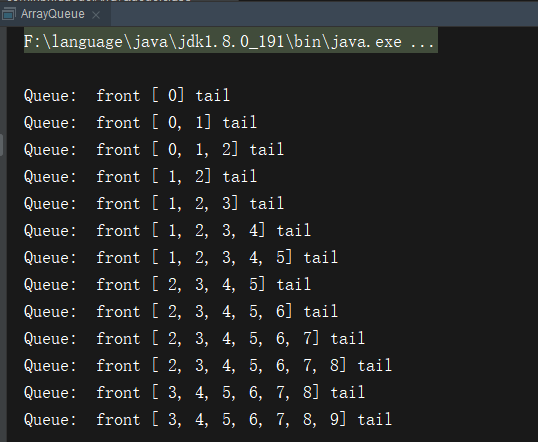
复杂度分析
| ArrayQueue<E> | |
|---|---|
| void enqueue(E e) | O(1)均摊 |
| E dequeue() | O(n) |
| E getFront | o(1) |
| int getSize | O(1) |
| boolean isEmpty() | O(1) |
如果使用顺序队列的话,试想一下如果我们队列十分的大,那么我们需要耗费的时间是多少呢。
循环队列
队列首位相接的顺序存储结构。

通过这样的方法,我们成功避免了数据搬移操作。看起来不难理解在用数组实现的非循环队列中,队满的判断条件是 tail == n,队空的判断条件是 head == tail。那针对循环队列,如何判断队空和队满呢?
队列为空的判断条件仍然是 head == tail。但队列满的判断条件就稍微有点复杂了。
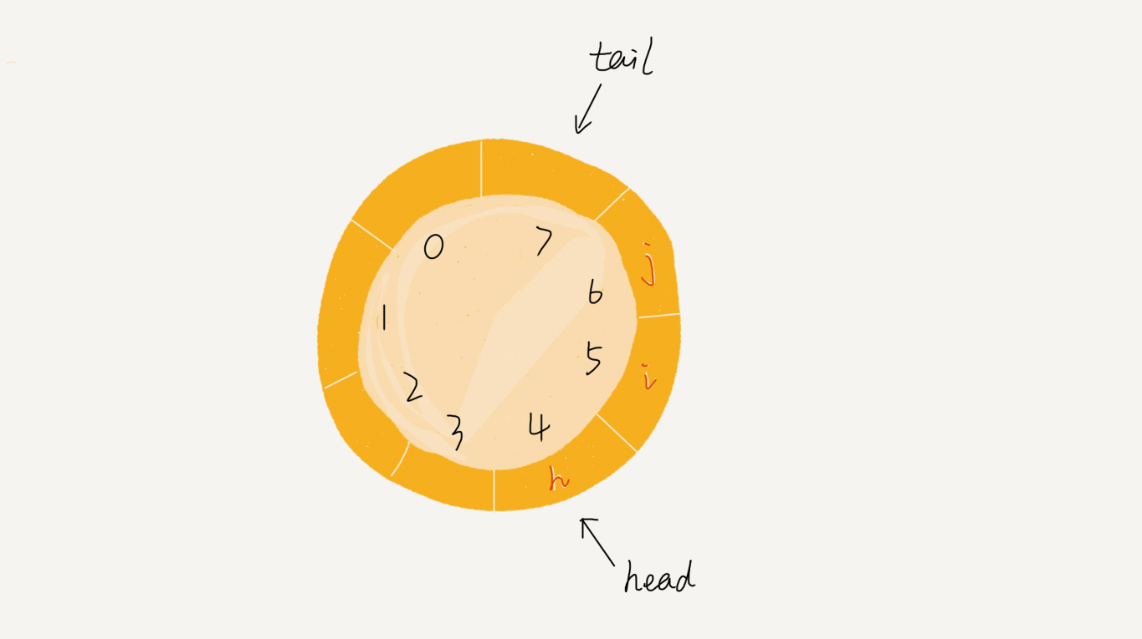
tail=3,head=4,n=8,所以总结一下规律就是:(3+1)%8=4。当队满时,(tail+1)%n=head,当队列满时,图中的 tail 指向的位置实际上是没有存储数据的。所以,循环队列会 浪费一个数组的存储空间。
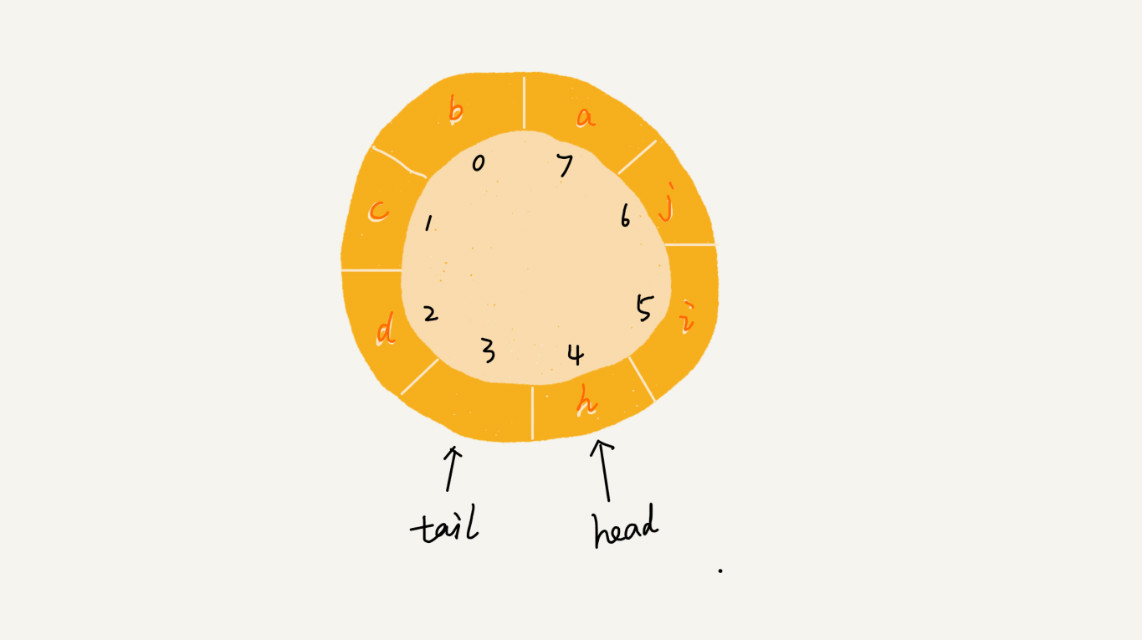
基于数组实现
循环队列需要我们单独去实现。
public interface Queue<E> {
int getSize();
boolean isEmpty();
void enqueue(E e);
E dequeue();
E getFront();
}public class LoopQueue<E> implements Queue<E> {
private E[] data;
private int front, tail;
private int size; // 有兴趣的同学,在完成这一章后,可以思考一下:
// LoopQueue中不声明size,如何完成所有的逻辑?
// 这个问题可能会比大家想象的要难一点点:)
public LoopQueue(int capacity){
data = (E[])new Object[capacity + 1];
front = 0;
tail = 0;
size = 0;
}
public LoopQueue(){
this(10);
}
public int getCapacity(){
return data.length - 1;
}
@Override
public boolean isEmpty(){
return front == tail;
}
@Override
public int getSize(){
return size;
}
@Override
public void enqueue(E e){
if((tail + 1) % data.length == front)
resize(getCapacity() * 2);
data[tail] = e;
tail = (tail + 1) % data.length;
size ++;
}
@Override
public E dequeue(){
if(isEmpty())
throw new IllegalArgumentException("Cannot dequeue from an empty queue.");
E ret = data[front];
data[front] = null;
front = (front + 1) % data.length;
size --;
if(size == getCapacity() / 4 && getCapacity() / 2 != 0)
resize(getCapacity() / 2);
return ret;
}
@Override
public E getFront(){
if(isEmpty())
throw new IllegalArgumentException("Queue is empty.");
return data[front];
}
private void resize(int newCapacity){
E[] newData = (E[])new Object[newCapacity + 1];
for(int i = 0 ; i < size ; i ++)
newData[i] = data[(i + front) % data.length];
data = newData;
front = 0;
tail = size;
}
@Override
public String toString(){
StringBuilder res = new StringBuilder();
res.append(String.format("Queue: size = %d , capacity = %d\n", size, getCapacity()));
res.append("front [");
for(int i = front ; i != tail ; i = (i + 1) % data.length){
res.append(data[i]);
if((i + 1) % data.length != tail)
res.append(", ");
}
res.append("] tail");
return res.toString();
}
public static void main(String[] args){ //测试
LoopQueue<Integer> queue = new LoopQueue<>();
for(int i = 0 ; i < 10 ; i ++){
queue.enqueue(i);
System.out.println(queue);
if(i % 3 == 2){
queue.dequeue();
System.out.println(queue);
}
}
}
}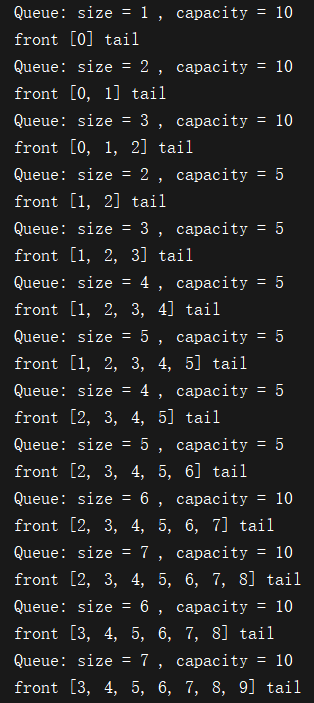
对比
import java.util.Random;
public class Main {
// 测试使用q运行opCount个enqueueu和dequeue操作所需要的时间,单位:秒
private static double testQueue(Queue<Integer> q, int opCount) {
long startTime = System.nanoTime();
Random random = new Random();
for (int i = 0; i < opCount; i++) {
q.enqueue(random.nextInt(Integer.MAX_VALUE));
}
for (int i = 0; i < opCount; i++) {
q.dequeue();
}
long endTime = System.nanoTime();
return (endTime - startTime) / 1000000000.0; //纳秒10^9
}
public static void main(String[] args) {
int opCount = 100000; //随机10万个数插入队列
ArrayQueue<Integer> arrayQueue = new ArrayQueue<>();
double time1 = testQueue(arrayQueue, opCount);
System.out.println("ArrayQueue, time: " + time1 + " s");
LoopQueue<Integer> loopQueue = new LoopQueue<>();
double time2 = testQueue(loopQueue, opCount);
System.out.println("LoopQueue, time: " + time2 + " s");
}
}
可见时间差距是将近200多倍。
应用
阻塞队列
阻塞队列在队列基础上增加了阻塞操作。在队列为空的时候,从队头取数据会被阻塞。因为此时还没有数据可取,直到队列中有了数据才能返回;如果队列已经满了,那么插入数据的操作就会被阻塞,直到队列中有空闲位置后再插入数据,然后再返回。

基于阻塞队列实现的“生产者 - 消费者模型”,可以有效地协调生产和消费的速度。当“生产者”生 产数据的速度过快,“消费者”来不及消费时,存储数据的队列很快就会满了。这个时候,生产者就阻塞等待,直到“消费者”消费了数据,“生产者”才会被唤醒继续“生产”。
而且不仅如此,基于阻塞队列,我可以通过协调“生产者”和“消费者”的个数,来提高数据的处理效率。比如前面的例子,我们可以多配置几个“消费者”,来应对一个“生产者”。

并发队列
线程安全的队列我们叫作并发队列。最简单直接的实现方式是直接在 enqueue()、dequeue() 方法 上加锁,但是锁粒度大并发度会比较低,同一时刻仅允许一个存或者取操作。实际上,基于数组的循环队列,利用 CAS 原子操作,可以实现非常高效的并发队列。这也是循环队列比链式队列应用 更加广泛的原因。
参考资料
《数据结构与算法之美》
《玩转数据结构》
《大话数据结构》



